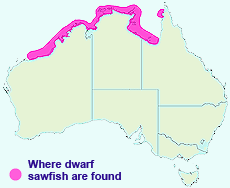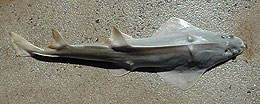Dwarf Sawfish
Pristis clavata (Garman, 1906)
Other names: broad billed sawfish
Conservation status: IUCN Red List - Critically endangered; NT - vulnerable
Description: moderately large thick bodied sawfish; skin rough; olive sandy brown dorsally and pale white ventrally; first dorsal fin origin over pelvic fin origin; no fork in caudal fin; 18 to 22 rostrum teeth extend onto base of saw; rostrum tapers distally unlike green and narrow sawfishes. |

Note: (1) rostral teeth generally opposite, (2) 1st dorsal fin origin slightly behind or over the top of pelvic fin origin, (3) straight caudal fin, rough skin |
| |
|
Descriptors:
1. 18 to 22 pairs of teeth extending onto base of saw
2. First dorsal fin origin over pelvic fin origin
3. No fork in caudal fin
4. rough skin
|
Pristis clavata (Garman, 1906)
The dwarf sawfish was first described in 1906 by Samuel Garman, a legendary anatomist and the first official curator of fishes, amphibians, and reptiles at the Museum of Comparative Zoölogy (MCZ) at Harvard University in the USA.. |
|
| |
|
 |
Distribution: Reported in very low abundances to inhabit isolated regions of the northern and western Gulf of Carpentaria. There are very few reports of dwarf sawfish caught in the southern Gulf of Carpentaria.
They are also found in the Northern Territory and Western Australia. Inhabits coastal foreshores and embayments mostly in its juvenile life stages and marine waters in its adult life stages. Adults seasonally frequent inshore waters throughout the year. Catches of dwarf sawfish are very low and are highly variable.
Size: Reported to reach at least 150cm, locally caught at 310cm. |
| |
|
Diet: Prawns and fish.
Fisheries: Commercial trawl, gill net and long line fisheries. Recreational line fishery and bait collection using small mesh cast nets and seine nets. Indigenous net and harpoon fishing. Foreign illegal gill nets and line fishing.
Utilisation: Meat and fins; rostrum trophy collectors; collection of live aquarium specimens. |

A photo of a young dwarf sawfish which has had its rostrum cut off. You can clearly tell the animal is emaciated and is struggling for survival, probably
slowly starving to death. |
|
|




